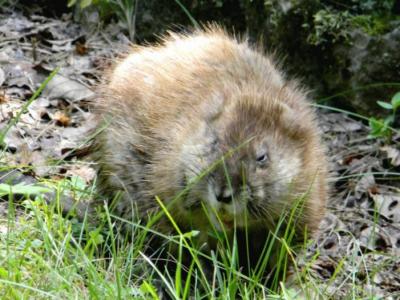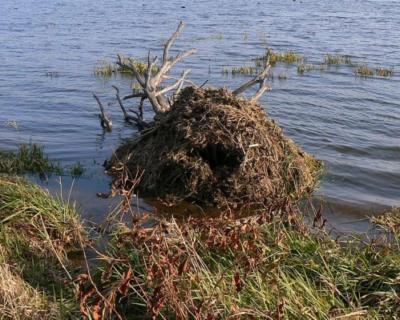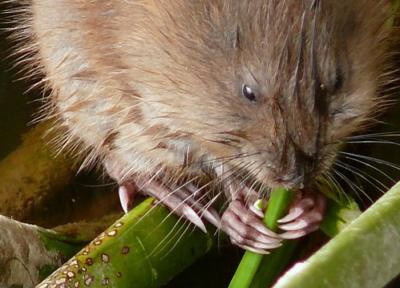 SKC Films Library SKC Films Library |
| SKC Films Library >> Science >> Zoology >> Mammals >> Order Rodentia |
| Muskrat Ondatra zibethica Description This large member of the vole family has a body length of 9-12 inches long and weighs 23-63 ounces. The scaly, vertically flattened tail is 7-11 inches long. It has short legs and big feet, a large head, and ears that are almost invisible underneath the fur. Well adapted to its aquatic lifestyle, the muskrat's hind feet are partly webbed and fringed with short stiff hairs. It is covered with short, thick fur that is medium to dark brown or black in color. The fur has two layers, which helps protect them from cold water. Muskrats have poorly developed senses of sight, hearing, and smell. They are affected by quick changes in temperature, and dry, hot weather is especially bad for them. A special adaptation called regional heterothermia regulates the flow of blood to the feet and tail, allowing these structures to be cooler than the body core. Musk glands at the base of the tail give this rodent its common name. Distribution and Habitat Muskrats are found throughout much of North America, from Alaska to Newfoundland south to Baja California and South Carolina. They have also been introduced into several parts of Europe, for their fur. Although they are found in ponds, lakes, and swamps, their favorite locations are marshes, where the water level stays constant, preferably 4-6 feet deep. They also require dense vegetation that provides both food and cover. The only time they are ever seen away from water is when they are searching for new feeding grounds. Habits The presence of muskrats in an area is shown by well-defined channels through the vegetation, slides down banks, and networks of tunnels. Muskrats can stay submerged for up to 12 minutes, and can swim both forwards and backwards. Muskrats make two kinds of nests. In open swamps a pile of aquatic vegetation is made that is about 4 feet high and 5 feet across. The walls are cemented with mud and a nest of finely shredded leaves is made in the middle. Several tunnels connect the nest with underwater exits. The other type of nest is built along the edges of ponds and rivers. The nest itself is a burrow dug into the bank or shoreline, with several entrances, both above the high water mark and underwater. Above water entrances are camouflaged with piles of vegetation. camouflaged entrance to a muskrat's
riverbank nest Muskrats form large family groups and live in definite territories. They continue to live in large groups even when fighting and cannibalism occur in high rates. They are active at all times of the day, but most active from mid-afternoon until just after dusk. Most communication is by musk, which also is used as a warning for intruders. They are capable of vocalizing by squeaks and squeals, but are usually quiet. Reproduction In the northern parts of their range, muskrats breed from spring to autumn, and several families are raised during that time. Breeding occurs year-round in the southern ranges, but births peak between November and April. Five to seven babies are born per litter, after a gestation of 22-30 days. Blind, naked, and helpless at birth, they can swim when they are about ten days old, begin to eat vegetation when they are about 20 days old, and are fully weaned at about 30 days old. Upon weaning they are driven out of the nest, which will likely be occupied by a new litter soon after. A single female may raise five litters a year. Both sexes can mate at about one year of age. Average lifespan is about three years. Diet Muskrats feed primarily on the roots and leaves of aquatic plants (such as waterlilies, wild rice, cattails, arrowheads, etc.), but will also go after crops such as maize, alfalfa, clover, and peanuts, and, occasionally, crayfish, mussels, and fish. Although a muskrat can close its mouth around its protruding teeth and chew underwater, it usually drags its food out to a feeding platform in the water or a feeding station near one of its travel paths. These feeding platforms are made of mud and vegetation. Scientific Classification phylum Chordata WEB SOURCE |
| SKC Films Library >> Science >> Zoology >> Mammals >> Order Rodentia This page was last updated on June 15, 2017. |



